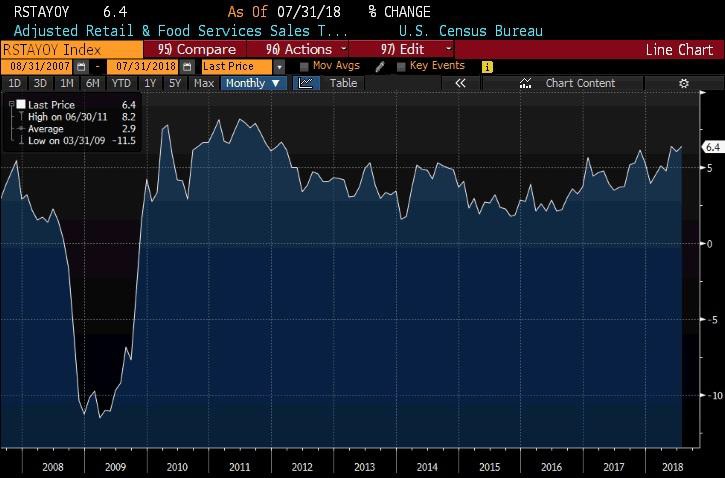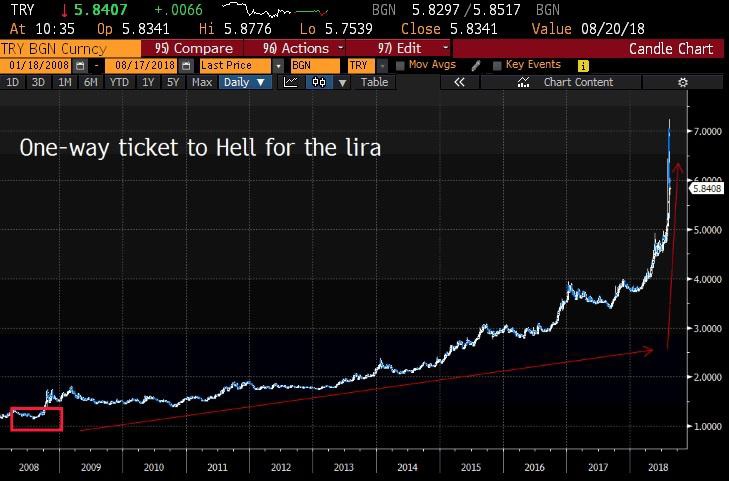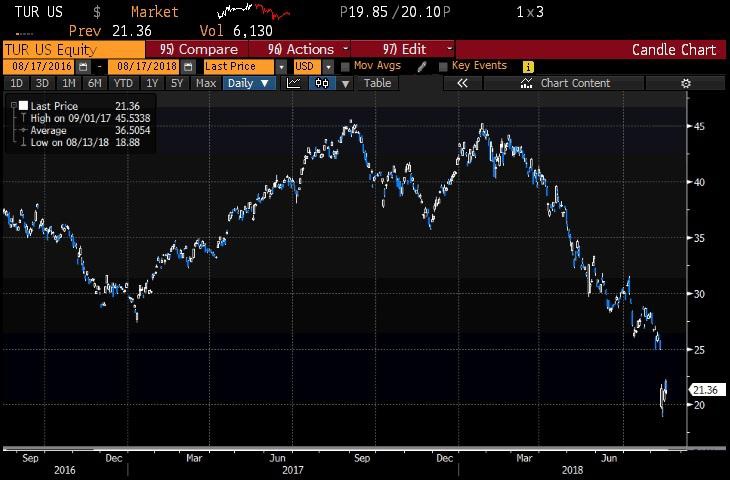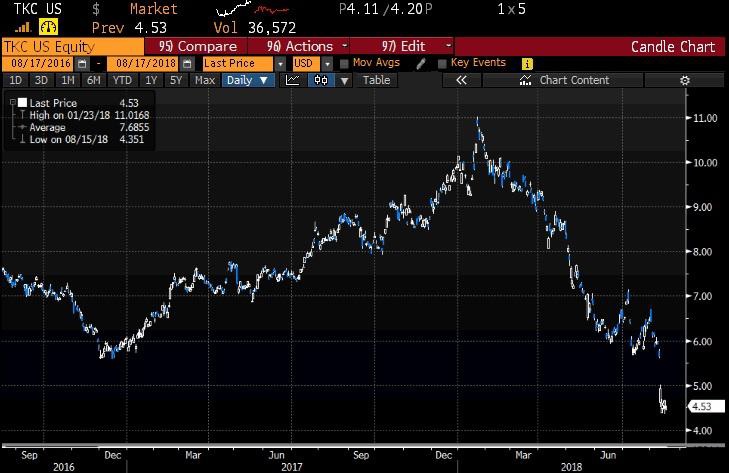Trade War or not to Trade War, that is the question. With the central banksters taking a secondary role in the determination of the direction of financial markets, traders (and the financial media) have needed to find other reasons this year to explain why the equity market does what it does. Although we knew that Donald Trump intended to Make America Great Again by renegotiating trade agreements (and this was a concern of the markets…up until election night in November 2016), markets have only recently begun to react to the implications of this Trump policy agenda. Interestingly enough, it has not been equities prices of U.S. companies that have taken a hit (although by definition, a trade war is bilateral). Since trade war fears hit the markets at the end of January, here are the performance numbers of the stock market indexes of the countries tied up in Trump’s trade war (through this Friday): It would appear that the pick-up in retail sales from 2017 corresponds to the new U.S. fiscal policy. Cut tax rates, even in the 9th year of an economic expansion, and you can still juice consumer spending. Our fear is that this will be a straw fire. The Federal government cannot cut taxes each two years to keep consumers spending. And if Trump loses the Republican majority in Congress, you can be sure that flagging retail sales in advance of a recession won’t be met by a new spending/tax cut bill.
It would appear that the pick-up in retail sales from 2017 corresponds to the new U.S. fiscal policy. Cut tax rates, even in the 9th year of an economic expansion, and you can still juice consumer spending. Our fear is that this will be a straw fire. The Federal government cannot cut taxes each two years to keep consumers spending. And if Trump loses the Republican majority in Congress, you can be sure that flagging retail sales in advance of a recession won’t be met by a new spending/tax cut bill. As we often point out, 90% of the damage in a bear market occurs in the last 10% of the time period of the bear market. We believe that we are seeing the capitulation in the lira right now, which will mark the end of this grueling bear market for TRY against the USD.Any time there is disorder in the world, look for the role of an orange-haired clown. And indeed, Trump is getting tagged as a contributor to the sell-off in Turkish assets. The Middle East’s largest economy has been targeted by the U.S. just like other nations around the world, including Canada. However Turkey is getting a double dose of Trump, as the POTUS decided to flex his muscle regarding the fate of an American pastor being held in Turkey (think about who are Trump’s grassroots supporters). Obviously, Erdogan, a fellow megalomaniac, cannot be shown up by Trump of the world stage, so the pastor will not be released. Instead, Erdogan said Turkey would boycott U.S.-made electronics such as Apple Inc.’s iPhone in response to U.S. sanctions, striking a defiant tone. Long story short, the lira fell -48% at one point on Monday just for the month of August! The Borsa Istanbul stock index added another -11.5% to its 2018 losses in just the past two weeks.Politics are politics. But the economy and valuations are completely separate, especially in an EM crisis. How many examples can we cite in which an EM political crisis created an extraordinary entry point for related EM assets?
As we often point out, 90% of the damage in a bear market occurs in the last 10% of the time period of the bear market. We believe that we are seeing the capitulation in the lira right now, which will mark the end of this grueling bear market for TRY against the USD.Any time there is disorder in the world, look for the role of an orange-haired clown. And indeed, Trump is getting tagged as a contributor to the sell-off in Turkish assets. The Middle East’s largest economy has been targeted by the U.S. just like other nations around the world, including Canada. However Turkey is getting a double dose of Trump, as the POTUS decided to flex his muscle regarding the fate of an American pastor being held in Turkey (think about who are Trump’s grassroots supporters). Obviously, Erdogan, a fellow megalomaniac, cannot be shown up by Trump of the world stage, so the pastor will not be released. Instead, Erdogan said Turkey would boycott U.S.-made electronics such as Apple Inc.’s iPhone in response to U.S. sanctions, striking a defiant tone. Long story short, the lira fell -48% at one point on Monday just for the month of August! The Borsa Istanbul stock index added another -11.5% to its 2018 losses in just the past two weeks.Politics are politics. But the economy and valuations are completely separate, especially in an EM crisis. How many examples can we cite in which an EM political crisis created an extraordinary entry point for related EM assets? Foreign investors will also earn the rebound in the lira. For a dollar investor, the same bond in hard currency would be effectively trading at a -60% discount to par.We have bought Turkish equities, an easier and more direct trade on our platforms. While the Borsa Istanbul index is down -25.6% YTD, the MSCI Turkey tracker (TUR) on New York (with exposure to lira) is down -49.3%. We bought this week for our DGR strategy during the fall (a nice price for the moment, around $20.80/share). The dividend yield is quite attractive after the price drop: 4.85% annual yield, paid in two installments. The next ex-dividend date is 12/18/2018.
Foreign investors will also earn the rebound in the lira. For a dollar investor, the same bond in hard currency would be effectively trading at a -60% discount to par.We have bought Turkish equities, an easier and more direct trade on our platforms. While the Borsa Istanbul index is down -25.6% YTD, the MSCI Turkey tracker (TUR) on New York (with exposure to lira) is down -49.3%. We bought this week for our DGR strategy during the fall (a nice price for the moment, around $20.80/share). The dividend yield is quite attractive after the price drop: 4.85% annual yield, paid in two installments. The next ex-dividend date is 12/18/2018. We also track Turkish companies that trade on New York via ADRs. On the basis of sound fundamentals, an exceptional dividend yield, and (apparently) a lower risk business, we are investing in Turkcell. Turkcell is a converged communication and technology services player with regional assets and globally relevant services. The Company provides mobile and fixed voice, data, television, and other services over its network in Turkey. Like most Turkish assets, this is a bloodbath, but we don’t see a permanent impairment to the company’s business. And with a 14.81% annual dividend right now (paid 3x per year, next detachment 9/17/2018) and gaining exposure to TRY/USD, we are rolling the dice on this one. We bought TKC (ticker on NYSE) at $4.70 this week, a bit too early despite the rebound in the currency. As we write, investors can get into TKC at $4.16. This is still like catching a falling knife, but we only put in a 3.2% position and can ride this out. It comes down to a guessing game and investor preference, but in these cases, buying on a rebound day of +8% and hoping it will continue is typically less successful than buying after a couple ugly down days.Turkish assets look scary and there is lots of fear-mongering in the media. However don’t be a Chicken — you can buy Turkey (if you respect our above advice)!
We also track Turkish companies that trade on New York via ADRs. On the basis of sound fundamentals, an exceptional dividend yield, and (apparently) a lower risk business, we are investing in Turkcell. Turkcell is a converged communication and technology services player with regional assets and globally relevant services. The Company provides mobile and fixed voice, data, television, and other services over its network in Turkey. Like most Turkish assets, this is a bloodbath, but we don’t see a permanent impairment to the company’s business. And with a 14.81% annual dividend right now (paid 3x per year, next detachment 9/17/2018) and gaining exposure to TRY/USD, we are rolling the dice on this one. We bought TKC (ticker on NYSE) at $4.70 this week, a bit too early despite the rebound in the currency. As we write, investors can get into TKC at $4.16. This is still like catching a falling knife, but we only put in a 3.2% position and can ride this out. It comes down to a guessing game and investor preference, but in these cases, buying on a rebound day of +8% and hoping it will continue is typically less successful than buying after a couple ugly down days.Turkish assets look scary and there is lots of fear-mongering in the media. However don’t be a Chicken — you can buy Turkey (if you respect our above advice)!
- China CSI 300 Index: -26.3%
- Europe Euro Stoxx Index: -7.1%
- Canada TSX Composite: -1.1%
- Mexico Bolsa: -6.1%
- Japan Nikkei: -7.8%
- U.S. S&P 500: -1.1%
- U.S. Nasdaq: +3.9%
 It would appear that the pick-up in retail sales from 2017 corresponds to the new U.S. fiscal policy. Cut tax rates, even in the 9th year of an economic expansion, and you can still juice consumer spending. Our fear is that this will be a straw fire. The Federal government cannot cut taxes each two years to keep consumers spending. And if Trump loses the Republican majority in Congress, you can be sure that flagging retail sales in advance of a recession won’t be met by a new spending/tax cut bill.
It would appear that the pick-up in retail sales from 2017 corresponds to the new U.S. fiscal policy. Cut tax rates, even in the 9th year of an economic expansion, and you can still juice consumer spending. Our fear is that this will be a straw fire. The Federal government cannot cut taxes each two years to keep consumers spending. And if Trump loses the Republican majority in Congress, you can be sure that flagging retail sales in advance of a recession won’t be met by a new spending/tax cut bill.Another Trump Victim
The other major news story of the week (if you can call the above announcement of low level China-U.S. talks a major news story) is the developing economic crisis in Turkey. To be clear, Turkey has been a basket case for a while, ever since the failed coup again President Recep Erdogan. The Turkish stock market peaked last January and has only fallen since (-29%). The Turkish lira has been falling since the financial crisis in 2008, which is exceptional as most emerging currencies have enjoyed some phase of relief since 2008. As we often point out, 90% of the damage in a bear market occurs in the last 10% of the time period of the bear market. We believe that we are seeing the capitulation in the lira right now, which will mark the end of this grueling bear market for TRY against the USD.Any time there is disorder in the world, look for the role of an orange-haired clown. And indeed, Trump is getting tagged as a contributor to the sell-off in Turkish assets. The Middle East’s largest economy has been targeted by the U.S. just like other nations around the world, including Canada. However Turkey is getting a double dose of Trump, as the POTUS decided to flex his muscle regarding the fate of an American pastor being held in Turkey (think about who are Trump’s grassroots supporters). Obviously, Erdogan, a fellow megalomaniac, cannot be shown up by Trump of the world stage, so the pastor will not be released. Instead, Erdogan said Turkey would boycott U.S.-made electronics such as Apple Inc.’s iPhone in response to U.S. sanctions, striking a defiant tone. Long story short, the lira fell -48% at one point on Monday just for the month of August! The Borsa Istanbul stock index added another -11.5% to its 2018 losses in just the past two weeks.Politics are politics. But the economy and valuations are completely separate, especially in an EM crisis. How many examples can we cite in which an EM political crisis created an extraordinary entry point for related EM assets?
As we often point out, 90% of the damage in a bear market occurs in the last 10% of the time period of the bear market. We believe that we are seeing the capitulation in the lira right now, which will mark the end of this grueling bear market for TRY against the USD.Any time there is disorder in the world, look for the role of an orange-haired clown. And indeed, Trump is getting tagged as a contributor to the sell-off in Turkish assets. The Middle East’s largest economy has been targeted by the U.S. just like other nations around the world, including Canada. However Turkey is getting a double dose of Trump, as the POTUS decided to flex his muscle regarding the fate of an American pastor being held in Turkey (think about who are Trump’s grassroots supporters). Obviously, Erdogan, a fellow megalomaniac, cannot be shown up by Trump of the world stage, so the pastor will not be released. Instead, Erdogan said Turkey would boycott U.S.-made electronics such as Apple Inc.’s iPhone in response to U.S. sanctions, striking a defiant tone. Long story short, the lira fell -48% at one point on Monday just for the month of August! The Borsa Istanbul stock index added another -11.5% to its 2018 losses in just the past two weeks.Politics are politics. But the economy and valuations are completely separate, especially in an EM crisis. How many examples can we cite in which an EM political crisis created an extraordinary entry point for related EM assets?- LatAm Sovereign Debt Crisis of 1982. Latin American currencies fell -65% on average in 1982. Once year later they were up +300%.
- Tequilla Crisis of 1994. Mexican peso fell -115%. In this case, investors needed to take profits on a rally of +22% which only lasted a couple of months.
- Asian Crisis of 1997-98. Thai baht fell -131% 1997-98. In 1999, the currency recovered +33%.
Trade Idea
For those investors on the outside, we believe that putting a reasonable percent of your portfolio in lira-denominated assets today will pay off, even if some patience is required. The keys are:- Position size. This is a crisis and anything can happen. We know the end result is not the collapse of Turkey and that the lira will eventually recover. If you take a disproportionately large position and another wave of selling occurs, you will be forced to sell where successful traders will be buying. This gets back to our old rule: “Never take a position larger than you should be taking – the gods of the financial markets disapprove, and they will let you know”.
- Buy on Weakness. Investors feel comfortable buying when an asset is rising. This is not the strategy to take in an EM crisis. Only buy on days that there is blood in the streets, no matter how much you are convinced the fall will continue.
 Foreign investors will also earn the rebound in the lira. For a dollar investor, the same bond in hard currency would be effectively trading at a -60% discount to par.We have bought Turkish equities, an easier and more direct trade on our platforms. While the Borsa Istanbul index is down -25.6% YTD, the MSCI Turkey tracker (TUR) on New York (with exposure to lira) is down -49.3%. We bought this week for our DGR strategy during the fall (a nice price for the moment, around $20.80/share). The dividend yield is quite attractive after the price drop: 4.85% annual yield, paid in two installments. The next ex-dividend date is 12/18/2018.
Foreign investors will also earn the rebound in the lira. For a dollar investor, the same bond in hard currency would be effectively trading at a -60% discount to par.We have bought Turkish equities, an easier and more direct trade on our platforms. While the Borsa Istanbul index is down -25.6% YTD, the MSCI Turkey tracker (TUR) on New York (with exposure to lira) is down -49.3%. We bought this week for our DGR strategy during the fall (a nice price for the moment, around $20.80/share). The dividend yield is quite attractive after the price drop: 4.85% annual yield, paid in two installments. The next ex-dividend date is 12/18/2018. We also track Turkish companies that trade on New York via ADRs. On the basis of sound fundamentals, an exceptional dividend yield, and (apparently) a lower risk business, we are investing in Turkcell. Turkcell is a converged communication and technology services player with regional assets and globally relevant services. The Company provides mobile and fixed voice, data, television, and other services over its network in Turkey. Like most Turkish assets, this is a bloodbath, but we don’t see a permanent impairment to the company’s business. And with a 14.81% annual dividend right now (paid 3x per year, next detachment 9/17/2018) and gaining exposure to TRY/USD, we are rolling the dice on this one. We bought TKC (ticker on NYSE) at $4.70 this week, a bit too early despite the rebound in the currency. As we write, investors can get into TKC at $4.16. This is still like catching a falling knife, but we only put in a 3.2% position and can ride this out. It comes down to a guessing game and investor preference, but in these cases, buying on a rebound day of +8% and hoping it will continue is typically less successful than buying after a couple ugly down days.Turkish assets look scary and there is lots of fear-mongering in the media. However don’t be a Chicken — you can buy Turkey (if you respect our above advice)!
We also track Turkish companies that trade on New York via ADRs. On the basis of sound fundamentals, an exceptional dividend yield, and (apparently) a lower risk business, we are investing in Turkcell. Turkcell is a converged communication and technology services player with regional assets and globally relevant services. The Company provides mobile and fixed voice, data, television, and other services over its network in Turkey. Like most Turkish assets, this is a bloodbath, but we don’t see a permanent impairment to the company’s business. And with a 14.81% annual dividend right now (paid 3x per year, next detachment 9/17/2018) and gaining exposure to TRY/USD, we are rolling the dice on this one. We bought TKC (ticker on NYSE) at $4.70 this week, a bit too early despite the rebound in the currency. As we write, investors can get into TKC at $4.16. This is still like catching a falling knife, but we only put in a 3.2% position and can ride this out. It comes down to a guessing game and investor preference, but in these cases, buying on a rebound day of +8% and hoping it will continue is typically less successful than buying after a couple ugly down days.Turkish assets look scary and there is lots of fear-mongering in the media. However don’t be a Chicken — you can buy Turkey (if you respect our above advice)!

